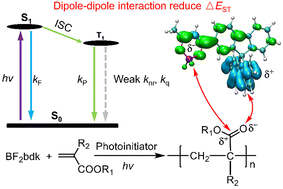Merging photoinitiated bulk polymerization and the dopant-matrix design strategy for polymer-based organic afterglow materials†
Abstract
Organic afterglow materials constitute an important class of luminescent materials because of their long-lived excited states. Among them, polymer-based organic afterglow materials exhibit excellent mechanical properties, which are necessary for their application in diverse circumstances. For their preparation, solution casting and melt casting are the most used techniques which require the use of solvents or high processing temperatures. Here, by merging photoinitiated polymerization and the dopant-matrix design strategy, we report a solvent-free method for the fabrication of polymer-based organic afterglow materials under very mild conditions. Liquid precursors formed by luminescent difluoroboron β-diketonate (BF2bdk) compounds, monomers and photoinitiators can directly produce BF2bdk-polymer afterglow materials after photoinitiated polymerization. The polymers have been found to interact with BF2bdk via dipole–dipole interactions, reduce the ΔEST values of BF2bdk excited states, and consequently enhance the intersystem crossing of BF2bdk excited states. The polymers can also provide a rigid environment for BF2bdk triplets to suppress their non-radiative decay and oxygen quenching. The obtained afterglow materials show diverse compositions, long afterglow emission lifetimes and high PLQYs and exhibit processability into 2D and 3D objects, as well as excellent flexibility to form foldable and stretchable objects.



 Please wait while we load your content...
Please wait while we load your content...